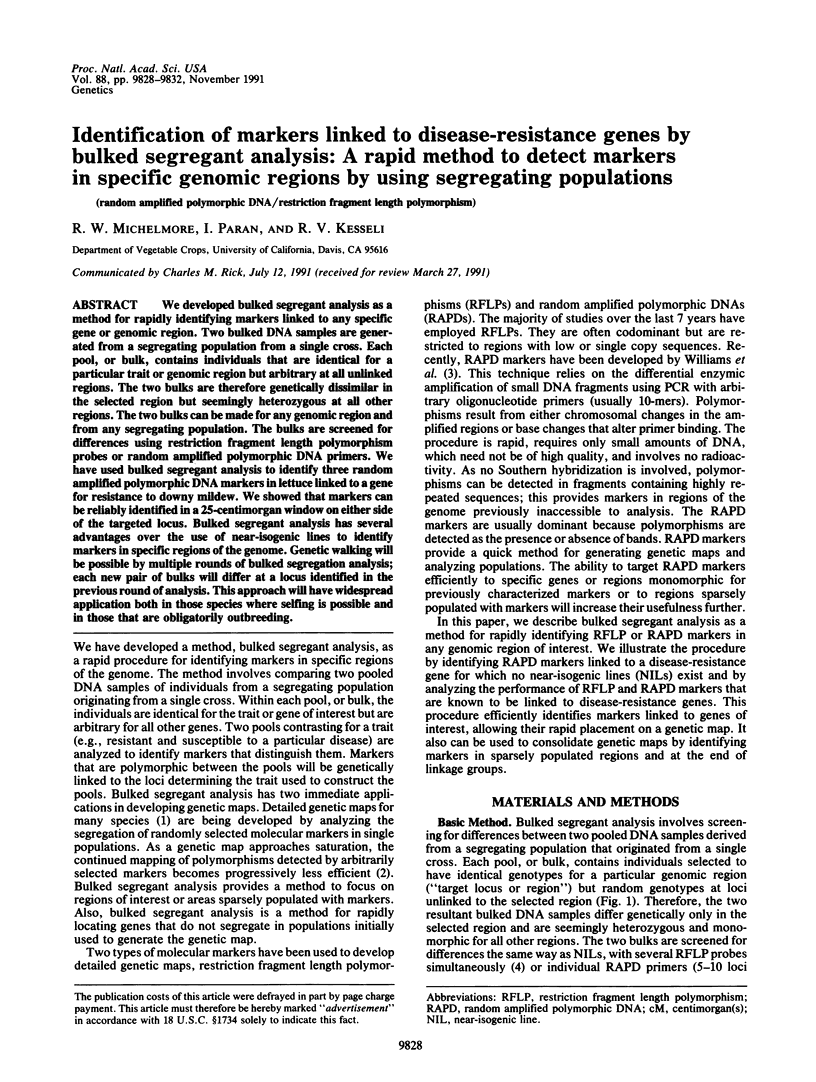Identification of markers linked to disease-resistance genes by bulked segregant analysis: a rapid method to detect markers in specific genomic regions by using segregating populations (original) (raw)
Abstract
We developed bulked segregant analysis as a method for rapidly identifying markers linked to any specific gene or genomic region. Two bulked DNA samples are generated from a segregating population from a single cross. Each pool, or bulk, contains individuals that are identical for a particular trait or genomic region but arbitrary at all unlinked regions. The two bulks are therefore genetically dissimilar in the selected region but seemingly heterozygous at all other regions. The two bulks can be made for any genomic region and from any segregating population. The bulks are screened for differences using restriction fragment length polymorphism probes or random amplified polymorphic DNA primers. We have used bulked segregant analysis to identify three random amplified polymorphic DNA markers in lettuce linked to a gene for resistance to downy mildew. We showed that markers can be reliably identified in a 25-centimorgan window on either side of the targeted locus. Bulked segregant analysis has several advantages over the use of near-isogenic lines to identify markers in specific regions of the genome. Genetic walking will be possible by multiple rounds of bulked segregation analysis; each new pair of bulks will differ at a locus identified in the previous round of analysis. This approach will have widespread application both in those species where selfing is possible and in those that are obligatorily outbreeding.

Images in this article
Selected References
These references are in PubMed. This may not be the complete list of references from this article.
- Helentjaris T., Weber D. F., Wright S. Use of monosomics to map cloned DNA fragments in maize. Proc Natl Acad Sci U S A. 1986 Aug;83(16):6035–6039. doi: 10.1073/pnas.83.16.6035. [DOI] [PMC free article] [PubMed] [Google Scholar]
- Lander E. S., Green P., Abrahamson J., Barlow A., Daly M. J., Lincoln S. E., Newberg L. A., Newburg L. MAPMAKER: an interactive computer package for constructing primary genetic linkage maps of experimental and natural populations. Genomics. 1987 Oct;1(2):174–181. doi: 10.1016/0888-7543(87)90010-3. [DOI] [PubMed] [Google Scholar]
- Landry B. S., Kesseli R. V., Farrara B., Michelmore R. W. A Genetic Map of Lettuce (Lactuca sativa L.) with Restriction Fragment Length Polymorphism, Isozyme, Disease Resistance and Morphological Markers. Genetics. 1987 Jun;116(2):331–337. doi: 10.1093/genetics/116.2.331. [DOI] [PMC free article] [PubMed] [Google Scholar]
- Michiels F., Burmeister M., Lehrach H. Derivation of clones close to met by preparative field inversion gel electrophoresis. Science. 1987 Jun 5;236(4806):1305–1308. doi: 10.1126/science.3035716. [DOI] [PubMed] [Google Scholar]
- Rommens J. M., Iannuzzi M. C., Kerem B., Drumm M. L., Melmer G., Dean M., Rozmahel R., Cole J. L., Kennedy D., Hidaka N. Identification of the cystic fibrosis gene: chromosome walking and jumping. Science. 1989 Sep 8;245(4922):1059–1065. doi: 10.1126/science.2772657. [DOI] [PubMed] [Google Scholar]
- Weber D., Helentjaris T. Mapping RFLP loci in maize using B-A translocations. Genetics. 1989 Mar;121(3):583–590. doi: 10.1093/genetics/121.3.583. [DOI] [PMC free article] [PubMed] [Google Scholar]
- Williams J. G., Kubelik A. R., Livak K. J., Rafalski J. A., Tingey S. V. DNA polymorphisms amplified by arbitrary primers are useful as genetic markers. Nucleic Acids Res. 1990 Nov 25;18(22):6531–6535. doi: 10.1093/nar/18.22.6531. [DOI] [PMC free article] [PubMed] [Google Scholar]
- Young N. D., Zamir D., Ganal M. W., Tanksley S. D. Use of isogenic lines and simultaneous probing to identify DNA markers tightly linked to the tm-2a gene in tomato. Genetics. 1988 Oct;120(2):579–585. doi: 10.1093/genetics/120.2.579. [DOI] [PMC free article] [PubMed] [Google Scholar]